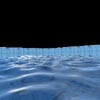
(J. Schneider, R. Westermann).
Abstract: In this work we demonstrate the benefits of the most current Nvidia graphics chip set for realistic simulation and rendering of dynamic water surfaces in real-time. In particular we employ programmable vertex shaders for the simulation of the water surface height field and for the displacement, transformation and lighting of vertices. To keep bandwith requirements low a superposition of Nurbs surfaces generated by the hardware through OpenGL evaluators and gradient noise implemented in the shader program itself is proposed. Furthermore, environment cube-mapping is used to enable realistic rendering. Our method can efficiently simulate effects such as refraction, reflection and the Fresnel term to model the optical characteristics of water. Although in this work only the simulation of a certain class of natural phenomena is exemplified, the proposed method is suitable for visually representing other effects as well.
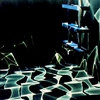
(Mark Watt)
A new two pass approach is presented based on a variation of backward ray tracing - backward beam tracing. Advantages include its capability of rendering complex, hitherto unattainable, specular to diffuse phenomenon and its easy insertion into standard renderers. The algorithm is applied to aspects of the interaction of light with water. Within this context a variety of first generation effects, including shadowing and light scattering, are both rendered and animated. Results taken from the treatment of caustics within classical optics are included as they provide valuable insights into the precise nature of specular to diffuse transfer.
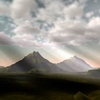
(Yoshinori Dobashi, Kazufumi Kaneda, Hideo Yamashita, Tsuyoshi Okita, Tomoyuki Nishita)
This paper proposes a simple and computationally inexpensive method for animation of clouds. The cloud evolution is simulated using cellular automaton that simplifies the dynamics of cloud formation. The dynamics are expressed by several simple transition rules and their complex motion can be simulated with a small amount of computation. Realistic images are then created using one of the standard graphics APIs, OpenGL. This makes it possible to utilize graphics hardware, resulting in fast image generation. The proposed method can realize the realistic motion of clouds, shadows cast on the ground, and shafts of light through clouds.
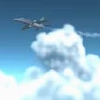
(Tomoyuki Nishita, Yoshinori Dobashi, Eihachiro Nakamae)
Methods to display realistic clouds are proposed. To display realistic images, a precise shading model is required: two components should be considered. One is multiple scattering due to particles in clouds, and the other factor to be considered is sky light. For the former, the calculation of cloud intensities has been assumed to be complex due to strong forward scattering. However, this paper proposes an efficient calculation method using these scattering characteristics in a positive way. The latter is a very significant factor when sky light is rather stronger than direct sunlight, such as at sunset/sunrise, even though sky light has been ignored in previous methods. This paper describes an efficient calculation method for light scattering due to clouds taking into account both multiple scattering and sky light, and the modeling of clouds.
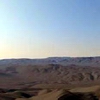
(A. J. Preetham, Peter Shirley, Brian Smits)
Sunlight and skylight are rarely rendered correctly in computer graphics. A major reason for this is high computational expense. Another is that precise atmospheric data is rarely available. We present an inexpensive analytic model that approximates full spectrum daylight for various atmospheric conditions. These conditions are parameterized using terms that users can either measure or estimate. We also present an inexpensive analytic model that approximates the effects of atmosphere (aerial perspective). These models are fielded in a number of conditions and intermediate results verified against standard literature from atmospheric science. These models are analytic in the sense that they are simple formulas based on fits to simulated data; no explicit simulation is required to use them. Our goal is to achieve as much accuracy as possible without sacrificing usability.
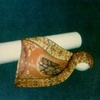
(Demetri Terzopoulos, John Platt, Alan Barr, Kurt Fleischer)
The theory of elasticity describes deformable ma- terials such as rubber, cloth, paper, and flexible metals. We employ elasticity theory to construct differential equations that model the behavior of non-rigid curves, surfaces, and solids as a function of time. Elastically deformable models are active: they respond in a natural way to applied forces, constraints, ambient media, and impenetrable obstacles. The models are fundamen- tally dynamic and realistic animation is created by numerically solving their underlying differential equations. Thus, the de- scription of shape and the description of motion are unified.
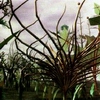
(Karl Sims)
This paper describes how evolutionary techniques of variation and selection can be used to create complex simulated structures, textures, and motions for use in computer graphics and animation. Interactive selection, based on visual perception of procedurally generated results, allows the user to direct simulated evolutions in preferred directions. Several examples using these methods have been implemented and are described. 3D plant structures are grown using fixed sets of genetic parameters. Images, solid textures, and animations are created using mutating symbolic lisp expressions. Genotjps consisting of symbolic expressions are presented as an attempt to surpass the limitations of fixed-length genotypes with predefine expression rules. his proposed that artificial evolution has potential as a powerful tool for achieving flexible complexity with a minimum of user input and knowledge of details.
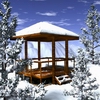
(Paul Fearing)
In this paper, we present a new model of snow accumulation and stability for computer graphics. Our contribution is divided into two major components, each essential for modelling the appearance of a thick layer of snowfall on the ground. Our accumulationmodel determines howmuch snowa particular surface receives, allowing for such phenomena as flake flutter, flake dusting and wind-blown snow. We compute snow accumulation by shooting particles upwards towards the sky, giving each source surface independent control over its own sampling density, accuracy and computation time. Importance ordering minimises sampling effort while maximising visual information, generating smoothly improving global results that can be interrupted at any point. Once snow lands on the ground, our stability model movesmaterial away from physically unstable areas in a series of small, simultaneous avalanches.We use a simple local stability test that handles very steep surfaces, obstacles, edges, and wind transit. Our stability algorithm also handles other materials, such as flour, sand, and flowing water.
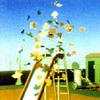
(Jackub Wejchert, David Haumann)
Methods based on aerodynamics are developed to simulate and control the motion of objects in fluid flows. To simplify the physics for animation, the problem is broken down into two parts: a fluid flow regime and an object boundary regime. With this simplification one can approximate the realistic behaviour of ohjects moving in liquids or air. It also enables a simple way of designing and controlling animation sequences: from a set of flow primitives, an animator can design the spatial arrangement of flows, create flows around obstacles and direct flow timing. The approach is fast, simple, and is easily fitted into simulators that rnodel objects governed by classical mechanics. The methods are applied to an animation that involves hundreds of flexible leaves being blown by wind currents.
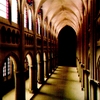
(John R. Wallace, Kells A. Elmquist, Eric A. Haines)
A new method for computing form-factors within a progres- sive radiosity approach is presented. Previously, the progres- sive radiosity approach has depended on the use of the hemi-cube algorithm to determine form-factors. However, sampling problems inherent in the hemi-cube algorithm limit its usefulness for complex images. A more robust approach is described in which ray tracing is used to perform the numerical integration of the form-factor equation. The approach is tailored to provide good, approximate results for a low number of rays, while still providing a smooth contin- uum of increasing accuracy for higher numbers of rays. Quantitative comparisons between analytically derived form- factors and ray traced form-factors are presented.
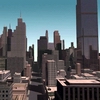
(Yoav I H Parish, Pascal Müller)
Modeling a city poses a number of problems to computer graphics. Every urban area has a transportation network that follows population and environmental influences, and often a superimposed pattern plan. The buildings appearances follow historical, aesthetic and statutory rules. To create a virtual city, a roadmap has to be designed and a large number of buildings need to be generated. We propose a system using a procedural approach based on L-systems to model cities. From various image maps given as input, such as land-water boundaries and population density, our system generates a system of highways and streets, divides the land into lots, and creates the appropriate geometry for the buildings on the respective allotments. For the creation of a city street map, L-systems have been extended with methods that allow the consideration of global goals and local constraints and reduce the complexity of the production rules. An L-system that generates geometry and a texturing system based on texture elements and procedural methods compose the buildings.

(Pascal Volino, Martin Courchesne, Nadia Magnenat Thalmann)
We are presenting techniques for simulating the motion and the deformation of cloth, fabrics or, more generally, deformable surfaces. Our main goal is to be able to simulate any kind of surface without imposing restrictions on shape or geometrical environment. In particular, we are considering difficult situations with respect to deformations and collisions, like wrinkled fabric falling on the ground. Thus, we have enhanced existing algorithms in order to cope with any possible situation. A mechanical model has been implemented to deal with any irregular triangular meshes, handle high deformations despite rough discretisation, and cope with complex interacting collisions. Thus, it should deal efficiently with situations where nonlinearities and discontinuities are really non marginal. Collision detection has also been improved to efficiently detect self-collisions, and also to correctly consider collision orientations despite the lack of surface orientation information from preset geometrical contexts, using consistency checking and correction. We illustrate these features through simulation examples.
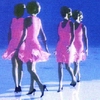
(Michel Carignan, Ying Yang, Nadia Magnenat Thalrnann, Daniel Thalrnann)
This paper discusses the use of physics-based models for animating clothes on synthetic actors in motion. In our approach, cloth pieces are fist designed with polygonal panels in two dimensions, and are then seamed and attached to the actor’s body in three dimensions. After the clothes are created, physical properties are simulated and then clothes are animated according to the actor’s motion in a physical environment. We describe the physical models we use and then address several problems we encountered. We examine how to constrain the elements of deformable objects which are either seamed together or attached to rigid moving objects. We also describe a new approach to the problem of handling collisions among the cloth elements themselves, or between a cloth element and a rigid object like the human body. Finally, we discuss how to reduce the number of parameters for improving the interface between the animator and the physics-based model.
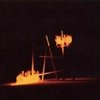
(Jos Stam, Eugene Fiume)
Developing a visually convincing model of fire, smoke, and other gaseous phenomenais among themost difficult and attractive problems in computer graphics. We have created new methods of animating a wide range of gaseous phenomena, including the particularly subtle problemofmodelling “wispy” smoke and steam, using far fewer primitives than before. One significant innovation is the reformulation and solution of the advection-diffusion equation for densities composed of “warped blobs”. These blobs more accuratelymodel the distortions that gases undergo when advected by wind fields. We also introduce a simplemodel for the flame of a fire and its spread. Lastly, we present an efficient formulation and implementation of global illumination in the presence of gases and fire. Our models are specifically designed to permit a significant degree of user control over the evolution of gaseous phenomena.
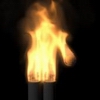
(Duc Quang Nguyen, Ronald Fedkiw, Henrik Wann Jensen)
We present a physically based method for modeling and animating fire. Our method is suitable for both smooth (laminar) and turbulent flames, and it can be used to animate the burning of either solid or gas fuels. We use the incompressible Navier-Stokes equations to independently model both vaporized fuel and hot gaseous products. We develop a physically based model for the expansion that takes place when a vaporized fuel reacts to form hot gaseous products, and a related model for the similar expansion that takes place when a solid fuel is vaporized into a gaseous state. The hot gaseous products, smoke and soot rise under the influence of buoyancy and are rendered using a blackbody radiation model. We also model and render the blue core that results from radicals in the chemical reaction zone where fuel is converted into products. Our method allows the fire and smoke to interact with objects, and flammable objects can catch on fire.
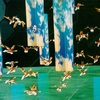
(Craig W. Reynolds)
The aggregate motion of a flock of birds, a herd of land ani- mals, or a school of fish is a beautiful and familiar part of the natural world. But this type of complex motion is rarely seen in computer animation. This paper explores an approach based on simulation as an alternative to scripting the paths of each bird individually. The simulated flock is an elaboration of a particle system, with the simulated birds being the particles. The aggregate motion of the simulated flock is created by a distributed behavioral model much like that at work in a natu- ral flock; the birds choose their own course. Each simulated bird is implemented as an independent actor that navigates ac- cording to its local perception of the dynamic environment, the laws of simulated physics that rule its motion, and a set of behaviors programmed into it by the "animator." The aggregate motion of the simulated flock is the result of the dense interaction of the relatively simple behaviors of the individual simulated birds.
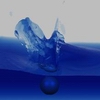
(Nick Foster, Ronald Fedkiw)
We present a general method for modeling and animating liquids. The system is specifically designed for computer animation and handles viscous liquids as they move in a 3D environment and interact with graphics primitives such as parametric curves and moving polygons. We combine an appropriately modified semi- Lagrangian method with a new approach to calculating fluid flow around objects. This allows us to efficiently solve the equations of motion for a liquid while retaining enough detail to obtain realistic looking behavior. The object interaction mechanism is extended to provide control over the liquid’s 3D motion. A high quality surface is obtained from the resulting velocity field using a novel adaptive technique for evolving an implicit surface.